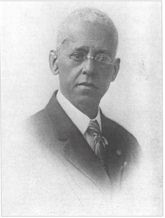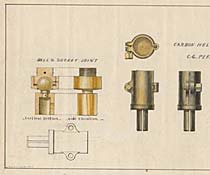Lewis Latimer: Difference between revisions
No edit summary |
No edit summary |
||
| Line 19: | Line 19: | ||
Latimer married Mary Wilson on 10 December 1873, and they had two children, Emma Jeannette, born in 1883, and Louise Rebecca, born in 1890. Throughout his life, Latimer was also interested in poetry, the arts, and civil rights. | Latimer married Mary Wilson on 10 December 1873, and they had two children, Emma Jeannette, born in 1883, and Louise Rebecca, born in 1890. Throughout his life, Latimer was also interested in poetry, the arts, and civil rights. | ||
[[Image:Latimer drawing.jpg|right|Electricity pioneer Lewis Latimer drew this component of an arc lamp, an early type of electric light, for the U.S. Electric Lighting Company in 1880.]]<br>'''Notable Patents:''' | |||
Water closet for railroad cars (1874) <br>Improvement to electric lamp (1881) <br>Process for manufacturing carbon filament (1882) <br>Arc light globe support (1882) <br>Apparatus for cooling and disinfecting (1886) <br>Device for locking hats, coats and umbrellas on hanging racks (1895) <br>Lamp fixture (1910) | Water closet for railroad cars (1874) <br>Improvement to electric lamp (1881) <br>Process for manufacturing carbon filament (1882) <br>Arc light globe support (1882) <br>Apparatus for cooling and disinfecting (1886) <br>Device for locking hats, coats and umbrellas on hanging racks (1895) <br>Lamp fixture (1910) | ||
Revision as of 13:02, 3 September 2008
Lewis Latimer: An Edison Pioneer
<pageby nominor="false" comments="false"></pageby>
Biography:
Lewis Howard Latimer was born to George and Rebecca Latimer on 4 September 1848, the youngest of four children (three boys and one girl). He attended only grade school, and the remainder of his education was self-taught. At the age of 10 he began working with his father in order to support the family. He has a fabulous appetite for reading, drawing, and learning in general.
The son of a former slave, Latimer had bitter feelings about slavery. At the age of 15, he falsified the date on his birth certificate and enlisted in the Union Navy during the Civil War. After receiving an honorable discharge, Latimer returned to Boston. His first job was as an office boy with Crosly and Gage, a well-known Boston patent law firm. He taught himself drafting and, after recognizing his talents, the firm promoted him to draftsman. One of his assignments was to make the initial drawings for one of Alexander Graham Bell’s telephone patents.
In 1880, Herman Maxim, Chief Engineer and Electrician for the United States Lighting Company, who was very impressed with Latimer’s talents as a draftsman, hired him. Latimer took this opportunity to learn about the electric industry. During his tenure with Maxim, he invented an electric lamp with a carbon filament (1881). He traveled to London to advise the English on setting up a lamp factory.
In 1885 he began his association with Thomas Edison, serving as an engineer, chief draftsman, and expert witness on the Board of Patent Control in gathering evidence against the infringement of patents held by General Electric and Westinghouse. He was named an Edison Pioneer in 1918, an elite group of men who worked for Edison.
Latimer married Mary Wilson on 10 December 1873, and they had two children, Emma Jeannette, born in 1883, and Louise Rebecca, born in 1890. Throughout his life, Latimer was also interested in poetry, the arts, and civil rights.
Notable Patents:
Water closet for railroad cars (1874)
Improvement to electric lamp (1881)
Process for manufacturing carbon filament (1882)
Arc light globe support (1882)
Apparatus for cooling and disinfecting (1886)
Device for locking hats, coats and umbrellas on hanging racks (1895)
Lamp fixture (1910)
Retirement:
He retired in 1924 at the age of 75. He passed away at his home in Flushing, New York on 11 November 1928, at the age of 80. Upon his death, the Edison Pioneers published an obituary that included the following testimonial:
“He was of the colored race, the only one in our organization, and was one of those to respond to the initial call that led to the formation of the Edison Pioneers, January 24th 1918. Broadmindedness, versatility in the accomplishment of things intellectual and cultural, a linguist, a devoted husband and father, all were characteristic of him, and his genial presence will be missed from our gatherings.”
Further Reading:
1) At Last Recognition in America: A Reference Handbook of Unknown Black Inventors and Their Contributors to America, Volume 1. James C. Williams, compiler. (Chicago, IL: B.C.A. Publishing Corp.), 1978. p. 16-17.
2) Black Pioneers of Science and Invention.
Louis Haber. (New York, NY: Harcourt, Brace & World), 1970. p.49-60.
3) Blacks in Science: Ancient and Modern.
Ivan Van Sertima. (New Brunswick: Transition Books), 1984. p. 229-237.
4) Dictionary of American Negro Biography.
Rayfor W. Logan and Michael R. Winston, eds. (New York, NY: Norton), 1982. p. 385-386.
5) Eight Black American Inventors.
Robert C. Hayden. (Reading, MA: Addison-Wesley), 1972. p. 78-92.
6) Encyclopedia of Black America. 1985
Augustus Low and Virgil A. Clift, eds. (New York, NY: McGraw-Hill), 1981. p. 497.
7) Hidden Contributors: Black Scientists and Inventors in America.
Aaron E. Klein. (Garden City, NY: Doubleday), 1971. p. 97-108.
8) Negro Year Book, 1931
(Tuskegee, AL : Negro Year Book Pub. Co.), p. 185-186.
9) Who's Who of the Colored Race: A General Biographical Dictionary of Men and Women of African Descent. 1915
Frank Lincoln Mather, ed. (Detroit, MI: Gale Research Co.), 1976. p. 172.
<rating comment="false"> Well Written? 1 (No) 2 3 4 5 (Yes) </rating> <rating comment="false"> Informative? 1 (No) 2 3 4 5 (Yes) </rating> <rating comment="false"> Accurate? 1 (No) 2 3 4 5 (Yes) </rating>

